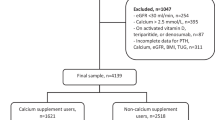Abstract
The reference range for 25-hydroxyvitamin D (25-OHD) remains uncertain, and it is not clear as to whether interpretation of circulating 25-OHD would be aided by simultaneous measurement of serum parathyroid hormone (PTH). We wanted to define the level of serum 25-OHD associated with a raised serum PTH and to examine the determinants of the relationship between serum 25-OHD and serum PTH concentration. We retrospectively examined data for patients who had a 25-OHD measurement and other biochemical variables over a 12-month period in our center. We found that 28% of patients had a serum 25-OHD level below 50 nmol/L and serum PTH level in the normal reference range, whereas 24% had a serum 25-OHD level below 50 nmol/L with a serum PTH value above the normal reference range. At a serum 25-OHD level of 80 nmol/L, 1.5% had an elevated serum PTH and, at 50 nmol/L, 8% had raised serum PTH. Further examination showed that for patients with low serum 25-OHD, low glomerular filtration rate (GFR) was a major determinant of the PTH response. These data confirm an inverse correlation between serum 25-OHD and serum PTH. Minimal numbers of patients (1.5% of the study group) have a raised serum PTH at a serum 25-OHD level of 80 nmol/L. GFR is a major determinant of the PTH response to decreasing serum levels of 25-OHD.



Similar content being viewed by others
References
Hollis B (2004) The determination of circulating 25-hydroxyvitamin D: no easy task. J Clin Endocrinol Metab 89:3149–3151
Binkley N, Krueger D, Cowgill CS, et al. (2004) Assay variation confounds the diagnosis of hypovitaminosis D. J Clin Endocrinol Metab 89:3152–3157
Dawson-Hughes B, Heaney RP, Holick MF, Lips P, Meunier PJ, Vieth R (2005) Estimates of optimal vitamin D status. Osteoporos Int 16:713–716
Holick M (2003) The parathyroid hormone D-lema. J Clin Endocrinol Metab 88:3499–3500
Lips P (2004) Which circulating level of 25-hydroxyvitamin D is appropriate? J Steroid Biochem Mol Biol 89/90:611–614
Vieth R, Fuleihan GE (2005) There is no lower threshold level for parathyroid hormone as 25-hydroxyvitamin D concentrations rise. J Endocrinol Invest 28:183–186
Heaney RP (2005) Serum 25-hydroxyvitamin D and parathyroid hormone exhibit threshold behaviour. J Endocrinol Invest 28:180–182
Lips P (2001) Vitamin D deficiency and secondary hyperparathyroidism in the elderly. Endocr Rev 22:477–501
Mosekilde L (2005) Vitamin D and the elderly. Clin Endocrinol 62:265–281
Bates CJ, Carter GD, Mishra GD, O’Shea D, Jones J, Prentice A (2003) In a population study, can parathyroid hormone aid the definition of adequate vitamin D status? A study of people aged 65 years and over from the British National Diet and Nutrition Survey. Osteoporos Int 14:152–159
Weaver CM, Fleet JC (2004) Vitamin D requirements: current & future. Am J Clin Nutr 80:1735S–1739S
Favus MJ (2005) Postmenopausal osteoporosis and the detection of so-called secondary causes of low bone density. J Clin Endocrinol Metab 90:3800–3801
Heaney RP (2003) Is the paradigm shifting? Bone 33:457–465
Tanpricha V, Pearce EN, Chen TC, Holick MF (2002) Vitamin D insufficiency among free-living healthy young adults. Am J Med 112:659–662
Isaia G, Giorgino R, Rini GB, Bevilacqua M, Maugeri D, Adami S (2003) Prevalence of hypovitaminosis D in elderly women in Italy: clinical consequences and risk factors. Osteoporos Int 14:577–582
Vieth R, Ladak Y, Walfish PG (2003) Age related changes in the 25-hydroxyvitamin D versus parathyroid hormone relationship suggest a different reason why older adults require more vitamin D. J Clin Endocrinol Metab 88:185–191
Sahota O, Mundey MK, San P, et al. (2004) The relationship between vitamin D and parathyroid hormone: calcium homeostasis, bone turnover, and bone mineral density in postmenopausal women with established osteoporosis. Bone 35:312–319
Pepe J, Romagnoli E, Nofroni I, et al. (2005) Vitamin D status as the major factor determining the circulating levels of parathyroid hormone: a study in normal subjects Osteoporos Int 16:805–812
Levey AS, Bosch JP, Lewis JB, Greene T, Rogers N, Roth D (1999) A more accurate method to estimate glomerular filtration rate from serum creatinine: a new prediction equation. Ann Intern Med 130:461–47020
National Kidney Foundation (2002) K/DOQI clinical practice guidelines for chronic kidney disease. Am J Kidney Dis 39:S1–S200
Sahota O, Gaynor K, Harwood RH, Hosking DJ (2001) Hypovitaminosis D and “functional hypoparathyroidism” – the NoNOF (Nottingham Neck of Femur) study. Age Ageing 30:467–472
Souberbielle JC, Cormier C, Kindermans C, et al. (2001) Vitamin D status and redefining serum parathyroid hormone reference in the elderly. J Clin Endocrinol Metab 86:3086–3090
Sahota O, Mundey MK, San P, Godber IM, Hosking DJ (2006) Vitamin D insufficiency and the blunted PTH response in established osteoporosis: the role of magnesium deficiency. Osteoporos Int 17:1013–1021
Zemel MB (2002) Regulation of adiposity and obesity risk by dietary calcium: mechanisms and implications. J Am Coll Nutr 21:146S–151S
McCarty MF, Thomas CA (2003) PTH excess may promote weight gain by impeding catecholamine-induced liplysis – implications for the impact of calcium, vitamin D and alcohol on body weight. Med Hypotheses 61:535–542
Garber AJ (1983) Effects of parathyroid hormone on skeletal muscle protein and amino acid metabolism in the rat. J Clin Invest 71:1806–1821
Sambrook PN, Chen JS, March LM, et al. (2004) Serum parathyroid hormone is associated with increased mortality independent of 25-hydroxyvitamin D status, bone mass and renal function in the frail and very old. J Clin Endocrinol Metab 89:5469–5476
Sambrook PN, Chen C, March LM, et al. (2004) Serum parathyroid hormone predicts time to first fall independent of vitamin D status in a frail elderly population. J Clin Endocrinol Metab 89:1572–1576
Author information
Authors and Affiliations
Corresponding author
Rights and permissions
About this article
Cite this article
Patel, S., Hyer, S. & Barron, J. Glomerular Filtration Rate Is a Major Determinant of the Relationship between 25-Hydroxyvitamin D and Parathyroid Hormone. Calcif Tissue Int 80, 221–226 (2007). https://doi.org/10.1007/s00223-007-9001-9
Received:
Accepted:
Published:
Issue Date:
DOI: https://doi.org/10.1007/s00223-007-9001-9




